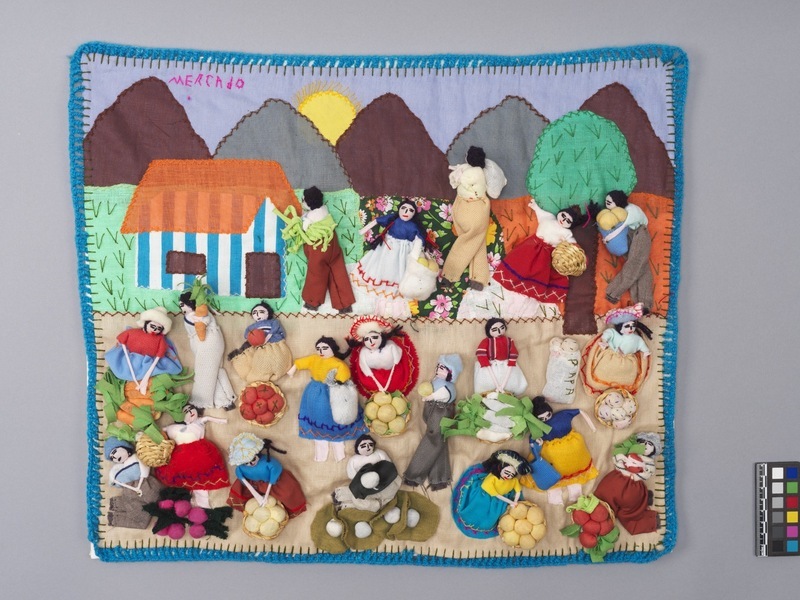Applique Item Number: 3479/1 from the MOA: University of British Columbia

Description
Applique textile (arpillera) depicting people in a market scene. Figures and merchandise are three-dimensional and stitched to the larger white cloth. Foreground of cloth is white-brown; middle ground is light green, orange, white and patterned; background is light blue-purple. Entire edge of cloth is trimmed with braided blue yarn. Brown and grey mountains in background, with sun rising in between them. White and blue striped house, with an orange roof, in middle ground towards left side, large tree towards right side. Green embroidery, imitating grass, across the middle. Figures are attached to the middle and foreground. All are white-pink and have black hair. They are wearing various outfits, including skirts, pants, brimmed hats, and short sleeved shirts. Some shirts and skirts have geometric designs, but most are unadorned. The vendors are all kneeling in the foreground with woven plant fibre baskets, full of produce, in front of them. Other people, carrying baskets or cloth bags, walk throughout. The word “Mercado” is embroidered in the top left corner. Textile is adhered to a foam board.
History Of Use
People started making arpilleras in Chile as a form of political protest. During the dictatorship of General Pinochet in the 1970s and 1980s, many men were arrested and never seen again. Their wives, mothers, and sisters were left alone to support their families. The women began sewing arpilleras as a way to earn money and also to tell the story of what was happening in their country. The Catholic Church secretly encouraged them, and sold the works abroad to help the dire financial position of the women who made them. Today, arpilleras are a popular Andean folk art, depicting scenes from daily life such as villages, markets and local festivals.
Narrative
The donor inherited the arpillera from her grandmother.
Item History
- Made in Peru during 1980
- Owned by Annie Burkes before February 26, 2021
- Received from Annie Burkes (Donor) on February 26, 2021
What
- Name
- Applique
- Identification Number
- 3479/1
- Type of Item
- applique
- Material
- synthetic wool fibre, cotton fibre and plant fibre
- Overall
- height 44.4 cm, width 52.1 cm
Who
- Culture
- Peruvian
- Previous Owner
- Annie Burkes
- Received from
- Annie Burkes (Donor)
Where
- Holding Institution
- MOA: University of British Columbia
- Made in
- Peru
When
- Creation Date
- during 1980
- Ownership Date
- before February 26, 2021
- Acquisition Date
- on February 26, 2021
Other
- Item Classes
- textiles
- Condition
- good
- Accession Number
- 3479/0001